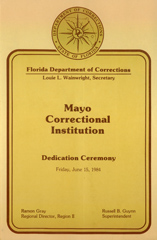1984
INMATE POPULATION JUNE 30, 1984: 26,471
January, 1984 - Denver, Colorado. The Florida Department of Corrections is awarded accreditation for the Central Office in Tallahassee. This makes the Florida Department of Corrections the largest fully accredited correctional agency in the United States. Secretary Louie L. Wainwright is presented a golden eagle by the American Correctional Association for its accomplishment.

The ACA Golden Eagle Award is presented to Secretary Wainwright.

Accreditation was an important step in the department's continuing improvement. Today all Florida corrections facilities are accreditated.
Mayo Correctional Institution (Mayo, FL) is dedicated on June 15, 1984.
Mayo Correctional Institution is dedicated on June 15, 1984. Click on the image to see the full Dedication Ceremony program.
By June 30, 1984, the prison population has grown to 26,471 and more funds are appropriated for prison beds to accommodate growth.
Administrative Gaintime (time off for good behavior) is created with the hopes of relieving overcrowding. (For more information, and a better understanding of release types & terms, see the Historical Summary of Sentencing and Punishment in Florida.)
The Corrections Mental Health Institution (CMHI) in Chattahochee, on the grounds of Florida State Hospital, opens. It provides in-patient treatment in a correctional setting for inmates committed under the 1982 Corrections Mental Health Act. Treatment is provided by staff from Florida State Hospital under contract with the Department. It also ends the practice of sending inmates with severe mental health problems to Florida State Hospital, where they were housed with the civilian population while receiving treatment. In 1998 CMHI and River Junction Correctional Institution will be combined into one facility called CMHI at River Junction. Then on October 14, 1999, the facility will close.
Putnam Correctional Institution (Palatka, FL) opens.
1985
OFFENDER POPULATION JUNE 30, 1985
INMATES: 28,310
SUPERVISED: 79,931
INMATES: 28,310
SUPERVISED: 79,931
Provisional Release Credits are implemented to relieve overcrowding.
"The Rock" housing facility at Raiford closes. It will not be torn down for another 14 years.
The first Personal Computers(PCs), (IBM XTs and ATs), are installed and used for the most rudimentary word processing and spreadsheets.
Martin Correctional Institution (Indiantown, FL) opens.

1970 aerial photo of "The Rock," the housing unit at Union Correctional Institution that was part of the original State Prison at Raiford.

Drug paraphernalia confiscated from inmates.
1986
OFFENDER POPULATION JUNE 30, 1986
INMATES: 29,712
SUPERVISED: 81,570
INMATES: 29,712
SUPERVISED: 81,570
On October 1, 1986, the Criminal Justice Standards and Training Commission requires all Department of Corrections Probation and Parole staff to be certified by the Florida Department of Law Enforcement (FDLE). Probation officers employed prior to that date are "grandfathered" in, however, all officers hired after October 1, 1986 are required to meet certain criteria and attend the Florida Corrections Academy for 10 weeks.
Monthly Cost of Supervision fees collected by probation officers and community control officers during fiscal year 1986-1987 total $14.7 million in revenue to the state. Restitution to victims of crime continues to be emphasized with payments by offenders totaling $10.9 million in fiscal year 1986-1987.
Offender Based Information System (OBIS): New databases implemented this year include the Special Review/Transfer Order (SR/TO) System. Also, the first Data General minicomputers are installed in the field for word processing and electronic mail on a network. Paper forms are converted to electronic (word processing) forms, simplifying the process previously completed on typewriters.
In July 1986, the Correctional Education School Authority (CESA) is established with Benjamin H. Groomes as its Director. Its purpose is to provide inmates in academic and vocational training programs the opportunity to become literate and to learn a vocational trade. CESA would exist as an office separate from the Department of Corrections until July 1995.
Tents are erected to house the rapidly growing prison population. Within six years the inmate population has increased from 19,692 to 29,712.
- 1821-1845
- 1868-1876
- 1877-1895
- 1900-1919
- 1921
- 1922-1924
- 1927
- 1928-1931
- 1932 | CHAPMAN
- 1933-1935
- 1936-1939
- 1940-1945
- 1946-1949
- 1950-1955
- 1956-1961
- 1962 | WAINWRIGHT
- 1963-1965
- 1966-1969
- 1970-1975
- 1976-1979
- 1980-1986
- 1987 | DUGGER
- 1988-1990
- 1991 | SINGLETARY
- 1992-1995
- 1996-1998
- 1999 | MOORE
- 2000-2002
- 2003 | CROSBY
- 2004-2005
- 2006 | MCDONOUGH
- 2007
- 2008 | MCNEIL
- 2009-2010
- 2011 | BUSS
- 2011 | TUCKER
- 2012 | CREWS
- 2013-2014
- 2014 | JONES
- 2015-2018
- 2019 | INCH
- 2020-2021
- 2021 | DIXON
- 2022-Today
- Population Summary Table


